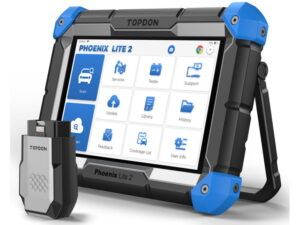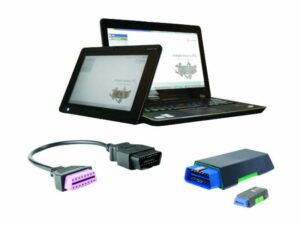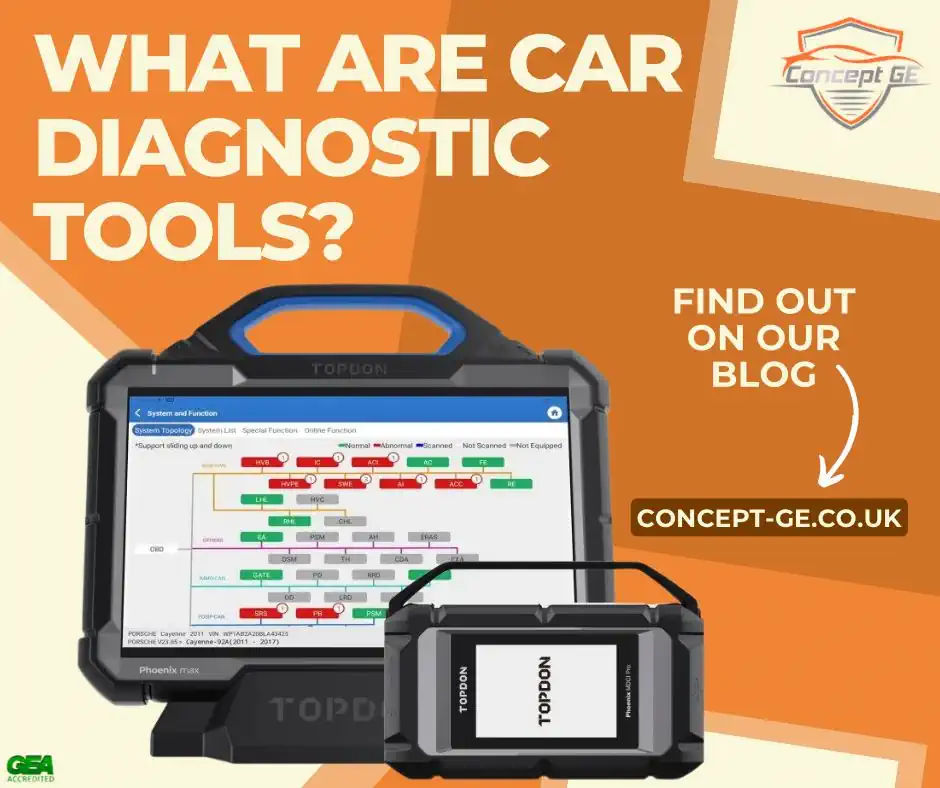Whether you are a mechanic running a large workshop, MOT bay, or a small local independent garage, there are many advantages to owning diagnostic equipment in your toolbox.
Car diagnostic tools and OBD2 scanners work by scanning a car’s components and systems, like a stethoscope for vehicle electronics, to help look for any issues that might be present with parts like the engine, ignition system, transmission, oil tank, accelerator, and more.
However, since these tests need special devices and expertise to be read accurately, they are usually carried out by mechanics at garages or MOT testing stations.
A vehicle diagnostic tool is a diagnostic scanner that can be plugged into an OBD (OBD I) or OBD2 (OBD II) socket to read and clear codes, as well as view data readouts from various sensors. This can be used to help diagnose problems with a vehicle.
This data can reveal:
- Trouble codes: These cryptic codes point to potential problems, like a faulty sensor or failing component.
- Live sensor data: See real-time readings from various sensors, helping pinpoint the issue’s source.
- System health reports: Get an overall picture of the car’s health, identifying areas needing attention.
What does OBD stand for?
OBD stands for On-Board Diagnostics. This acronym is used to identify a device that can be connected to a car or other vehicle via the OBD port or OBD2 port usually via an OBD cable.
What can an OBD tell you?
OBD or onboard diagnostics is the car’s electronic system that controls and monitors and does its best to diagnose faults with the electrical and mechanical parts of the vehicle, and the ODB port offers data access to technicians armed with car diagnostics tools to these monitoring codes via the on-board hardware and software.
The daily job of the OBD is its ability to inform the driver of any error codes or abnormal behaviours about their vehicle within the dashboard of the vehicle via warning lights and sounds. And the history of these codes, known as diagnostic trouble codes or fault codes is stored within the car’s OBD memory.
When the correct and compatible car diagnostics scanner is plugged into the car ODB port, the history of these codes can be read, and some can be adjusted or reset, for example, once a fault has been fully diagnosed and repaired.
A typical example of such an error code is the engine warning light on the dashboard, in this example, you may not know exactly what the issue is, as this one light could indicate one of many types of engine fault from a dirty spark plug to a catastrophic engine failure. In this scenario the car diagnostic scanner is invaluable in gaining more insight into what may have caused the issue, as the error codes stored are usually much more granular in terms of identifying the reason for the light to illuminate.
Are OBD and OBD2 the same?
No. Fundamentally OBD and OBD2 are made to do the same job, to monitor and report on error codes within the vehicle. However, they are not the same.
OBD also known as OBD1 or OBD I was not standardised, and hence each manufacturer set its own standards, so an OBD1 scanner that fits one car may not work for another, also the codes used by one manufacturer could be very different from those used by another. This made it a very difficult and costly exercise for smaller independent garages to compete with the car dealerships in terms of offering ODB scanning, as they would need to have multiple scanners to cater for the vehicles they may need to diagnose and fix.
OBD2 often seen written as OBDII became mandatory for all petrol vehicles in Europe manufactured from January 1st 2001, and for diesel vehicles from 2004 (in the USA this was the standard from 1996), and this made a standardised fitment for all vehicles in terms of the port pinouts as well as the protocols used in the software. The OBD-II standard also provided an extensible list of Diagnostic Trouble Codes (DTCs). As a result of this standardisation, a single device can query the onboard computer in any vehicle.
What are the benefits of using diagnostic tools?
For some jobs, especially on cars with complex electronics (which is the vast majority on the road these days) a diagnostic scanner is fairly essential now, as well as meaning you can get the job done yourself without having to refer the customer to the main dealer, having one means
- Faster and more accurate diagnoses: Say goodbye to guesswork and hello to targeted repairs.
- Increased customer satisfaction: Solve problems quickly, keeping your customers happy and coming back.
- Improved repair efficiency: Focus on the root cause, saving time and money on unnecessary repairs.
What are the different types of car diagnostic tools?
Car diagnostic tools usually refer to the ODB or ODB2 tools used for diagnosing engine management, and electrical or mechanical faults with a car, but there are several other tools which fall into this category.
These are the top 5 types of car diagnostic scanners available today:
- ODB1 car scanners: used to scan Diagnostic Trouble Codes (DTC) on old vehicles, petrol cars earlier than 2001, diesel vehicles manufactured earlier than 2004 in the UK, and any vehicle manufactured before 1996 in the USA
- ODB2 car scanners: used to scan Diagnostic Trouble Codes (DTC) on all modern cars and vehicles
- Tyre Pressure Monitoring Systems (TPMS): used to monitor and alert to tyre pressure reduction or increase by 25% or more from manufacturers’ recommended inflation levels
- Circuit Testers and Multimeters: used to test electrical circuits and can be used to measure voltage, electric current, electrical resistance and electrical continuity to help determine where certain electrical problems may exist
- Car Battery Testers: a voltmeter used to test the charge in a car battery, often this functionality is combined with the ability to charge or trickle charge the battery and prevent overcharging by constantly monitoring the voltage and condition of the battery
What tool is used to diagnose cars?
An ODB or ODB2 scanner is a diagnostic tool that can be plugged into an OBD socket in a vehicle to read and clear codes, as well as view data readouts from various sensors. This can be used to help diagnose problems with a vehicle.
What is the best car diagnostic tool?
There are several types of car diagnostic tools available and also several manufacturers, some of which supply the software in a dedicated diagnostic device, such as the TOPDON range of car diagnostic tools.
Other diagnostic tools, such as the OTOFIX Powered by Autel diagnostics run on Android devices such as tablets and are usually sold bundled with the tablet and the software pre-loaded such that it can be used as a dedicated car diagnostic tool in a garage or workshop.
Other car diagnostic software can be run on android or ios devices, and some can be downloaded either free or paid from the play store and apple app store.
We can only recommend the high-quality car diagnostics tools that we stock and sell, as these are from reputable manufacturers with years of experience in this field, and backed up by first-class support teams.
Can I use my phone as a car diagnostic tool?
Yes, but it’s not necessarily the best tool for the job. Using an OBD or OBD2 connector and a mobile phone there are manufacturers who can supply software to read the OBD codes to diagnose issues with the vehicle and some can also update or reset these codes.
We do not stock any such devices and we would always recommend purchasing one of our high-quality professional car diagnostics tools that we stock.
If you decide to purchase an equivalent that will run on your phone, you do so at your own risk. Be sure to do your research well as there are a lot of alternatives available and in our experience, the majority do not work as well as a dedicated device, with good support and backup, as well as regularly updated software and database information.
Choosing the right diagnostic tool for you
The best tool depends on your needs and budget. Consider:
- Garage size and workload: For larger garages and MOT Bays, an advanced scanner might be worthwhile.
- Features needed: Identify must-have features based on the vehicle makes and models you specialise in.
- Ease of use: Choose a user-friendly tool that fits your team’s skill level.
If you are unsure what you need, or just need some advice, give our sales team a call on 0113 469 0572, we can address any questions you have and recommend the best diagnostic tools to meet your needs.
Is it worth buying a car diagnostic tool?
Yes. If you are a garage, workshop, MOT Bay or mobile mechanic then having a car diagnostic machine is an essential part of your toolbox. With almost all modern cars having elements controlled and monitored by the car’s computer and ODB system, the diagnosis of a problem can be done infinitely faster, or sometimes can only really be determined by the use of a car diagnostic tool.
With older cars prior to 2001, it is somewhat harder due to the ODB standard not being in place and hence it can be more difficult or expensive to ensure you have the correct equipment to read the codes from each vehicle, but for petrol cars built since 2001 and diesel since 2004, the ODB2 standard makes owning a single diagnostic device affordable and essential for any mechanic to have available to do their job quickly and efficiently.
What is an intelligent diagnostic tool?
An intelligent diagnostic tool goes a step further than simply providing error codes to be reviewed, analysed and reset, it will also supply more intelligent information and often guidance on how to attempt to resolve the diagnosed fault.
This can be very useful in speeding up fault finding and resolution, as well as allowing less experienced car mechanics to accelerate their learning and capability within the garage, workshop or MOT Bay.
How do I run a full diagnostic on my car?
If you have the correct car diagnostics tool, then the process is simple, and most good diagnostic tools will walk you through the process intelligently, but this is the process in its simplest form:
- Turn off the car engine and remove the key from the ignition
- Locate the OBD2 port on the vehicle, this is usually near, under or to the side of the steering wheel or underneath the dashboard. Some cars do have these located elsewhere but consult the manufacturer’s instruction manual if you are unsure
- Plug the diagnostic tool into the OBD2 port using the cabled or wireless device supplied
- Turn on the car diagnostic scanner tool
- Some scanners will automatically begin to scan the vehicle data, some others will walk you through some screens to get started and you may need to add some basic vehicle data including the VIN at this stage
- The scanning process may take several minutes or can be significantly longer, depending on the scanning tool and the vehicle being scanned
- The scanner should alert you to any codes needing your attention, and some will allow you to record the codes or download them to a computer
- Once the codes have been recorded, then you can turn off the vehicle ignition and begin to work on resolving any fault codes, such as vehicle repairs, service items or part replacements
- Once the repairs have been completed switch the ignition back on to re-read the codes, often codes that were there previously may remain and these will need to be reset manually using the scanner tool
- Some codes will be allowed to be cleared, assuming the problem has been resolved, but then you should use the vehicle for a while and re-scan to ensure the codes do not return, to confirm that the repair was completed successfully
Can you damage your car using an OBD2 Scanner?
Since ODB2 scanners are capable of both reading and writing data to your vehicle’s computer system some caution should be taken.
If you have a high-quality scanner from a reputable company then reading the codes should cause no concern, however, most car diagnostic scanners also allow you to update or reset codes, and this should be done with some caution, as resetting a warning of something dangerous within the vehicles system could result in a customer driving away in a car that is unsafe or likely to fail, which could in an extreme case be catastrophic.
There are a few things that can be done to avoid such issues
- Only use a name-brand professional car diagnostic scanner
- Always ensure the hardware and software you are using are up to date
- Ensure the car scanner you are using is suitable for the vehicle you are working on
- Make sure you have the correct training and skills to undertake both the diagnosis and the work involved to resolve any issues
If in doubt, talk to an expert, whether that be a more experienced mechanic, a car diagnostics expert or the car diagnostics tool supplier support staff.
How accurate is a car diagnostic test?
Car diagnostics tools differ in quality, but if the scanner you are using is a good quality professional device from a reputable manufacturer, and both the software and the database within it are up to date then this will help minimise the possibility of you getting inaccurate data from the diagnostic tool.
Bear in mind that, although the scanner will give you more information than the car dashboard, it is still limited to the codes available within the vehicle ODB system, and as such your knowledge and experience in diagnosing and interpreting the data will still be critical in getting to the root cause of any problems found quickly and accurately.
The ODB code cannot tell the technician or tester precisely what the problem is in some cases and even if you are using an intelligent diagnostic tool, the guidance given is purely based on the most likely cause and resolution of the problem.
It is however rare for a car diagnostics tool to be completely wrong. However, replacing a part or making a repair that addresses the error code might not fully fix the vehicle’s problem, as one issue or code may have been masking the effects of another. And you may have a recurring issue that has another root cause.
So always use a good quality scanner, ensure the data and software is up to date, and also always scan both before and after any car repairs are done to ensure that the issue has been resolved and that no further issues had previously been missed or undetected.
Help with your Car Diagnostic Tool
If you are considering purchasing a car diagnostic tool for your garage, view our selection online or speak to our sales team at Concept Garage Equipment first. We can advise on the best equipment to purchase to get you started with vehicle diagnostics or to upgrade to a better model as your business grows. Don’t forget even for mobile mechanics, having a professional car diagnostic tool is an essential device to help speed up your work and increase your revenue by ensuring you can provide this as a service to your customers.
We can offer you advice over the phone at 0113 469 0572, we sell Car Diagnostic Tools, Battery Testers and TPMS Programming tools both online and over the phone, and as with everything we sell, all product prices include delivery as well as free advice on the best use of the equipment, or indeed any other garage equipment up to a full MOT Bay installation.
Call us today on 0113 469 0572 or use the website contact form today, we are here to help.

Android Car Diagnostic Tool with OBD2

Car Diagnostic Tool with OBD2 and PC

Handheld Car Diagnostic Tool for TPMS Programming


